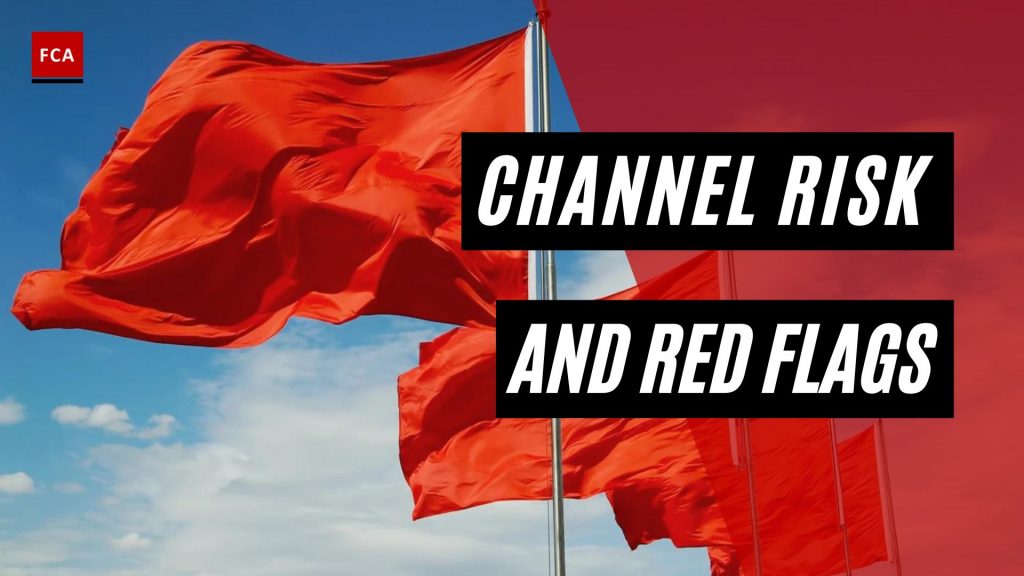The channel risk and red flags. Individuals, enterprises, and corporations are served through a variety of channels by the organization. Remittance channels, cash-based transactions, traditional financial transfer methods, wire transfers, and so on are examples of such channels.

Channel Risk And Red Flags
The misuse of the financial channel supplied to consumers by the financial institution for money laundering and/or terrorist funding is referred to as channel risk.
Money laundering and terrorist funding risk can be strongly influenced by the kind and features of the channels utilized to deliver services to clients. Organizations are required not to open fictitious accounts and initiate transactions that lack apparent economic sense or to be processed using high-risk channels.
The regulatory challenges and commercial, economic factors in many of the emerging markets, particularly the smaller economies, have resulted in a disproportionate increase in costs and implementation challenges, exacerbated by the impact of the withdrawal of the corresponding banking relationships. There has been a notable concentration of flows within trade lines and remittance channels, undermining smaller local banks, which can be critical to financial sector stability and the growth and prosperity of emerging market countries.
Customers may also perform the transaction using the financial channels, without face-to-face interaction, with the organization’s representatives. This increases the risk of ML/TF. In cases of face-to-face contact and transactions, the customers are restricted to remain anonymous, and it becomes easier to identify and verify the customer and beneficial owner.
At a minimum, the organizations are required to have a thorough understanding of the inherent ML/FT risks present in its delivery channels and services offered through these channels. The ML/TF risk assessment must consider the delivery channels. Certain delivery channels (for example, business relationships or transactions that do not face) may pose a higher ML/FT risk as they increase the challenge of verifying the customer’s identity and activities. The jurisdiction’s specific risks must also be assessed when the country’s risks are considered, due to their linking with each other, such as in cases of international remittances or inward remittances.
AML/KYC Policies
AML/KYC policies and procedures must include the channel risks to ensure that before customer acceptance, the appropriate due diligence and ongoing monitoring are performed for the customers and the channels used to deliver the services.
It is recommended that the ML/TF inherent risk-assessment questionnaire should cover critical areas of the bank’s business (for example, customers, geographies, products, services, transactions, and delivery channels. This may allow for all stakeholders to reach a common understanding of regulatory requirements in foreign jurisdictions, develop or follow AML/CFT best practices, or develop additional communication channels with foreign supervisors and pertinent correspondent banks.
Correspondent banks are required to collect and maintain sufficient information about the respondent bank. Sharing best practices between correspondent and respondent banks and between respondent banks themselves is important when assessing and responding to the risk of ML/TF associated with delivery channels.
Channel risk assessment enables the identification of potential gaps in AML/CFT risk management practices, and corrective actions are taken to support the maintenance of AML/CFT controls. Respondent banks are required to consider taking a proactive approach in assessing the channel risks and communicating with their correspondent banks to gain an understanding of correspondents’ risk tolerance level and local regulatory expectations. A respondent bank should use this information to enhance their AML/CFT controls and align them more closely with international standards, for example, FATF, Basel, Wolfsberg since these are the standards that many international correspondent banks look for as best practice.
Red Flags
Below are the channel risks related examples of red flags, which require review and investigations:
- The deposit or withdrawal of substantial amounts of cash from an account maintained in a high-risk jurisdiction;
- The refusal to provide CDD documentation on the wire transfers;
- The frequency with which wire transfers are made are inconsistent with the financial institution’s understanding of the customer and their circumstances transactions involving the unaccounted-for transportation of money, whether in cash or through wire transfers;
- The client is unable or unwilling to give information or plausible reasons to establish a business relationship, open an account, or execute a transaction with cross-border persons.
Higher Risks Worth Investigating
- Identity protection
- Individual and behavioral characteristics
- Notable business position or involvement
- Relationship with a high-risk industry or sector
- Business relationship or transaction type
- The kind of channel involvement
- Relationship to country-specific risks
Overall, FATF recommends that PEP screening be done on a risk-based basis. This means that if the role for which the investigated person is being considered is unlikely to provide opportunities for financial exploitation, then less stringent tests are required. As a result, the number of red flags raised by a person must be considered in the context of their future engagement.
Aside from the FATF, reporting authorities in various jurisdictions may provide their own list of indicators that organizations should consider.
What Are PEP Red Flags?
The FATF has developed a list of PEP red flags / indicators that can help detect PEP misuse of the financial system during a customer relationship. This list of indicators is useful in identifying PEPs who abuse the financial system and is not intended to stigmatize all PEPs. The context heavily influences how these indicators are interpreted. Matching one or two of these indicators frequently simply indicates a statistically increased risk of doing business with a specific customer, and several indicators may need to be met before serious suspicion is warranted. However, depending on the circumstances, matching just one or more of these indicators may lead directly to suspicion of illegal activity, such as money laundering.
Final Thoughts
Money laundering can cause a slew of problems for businesses, both qualitatively and quantitatively. Money laundering primarily conceals the criminals’ or money launderers’ illicit or unexplained income and source of funds. Furthermore, red flag indicators for AML/CFT harm the overall economy and pose numerous risks to business enterprises.









